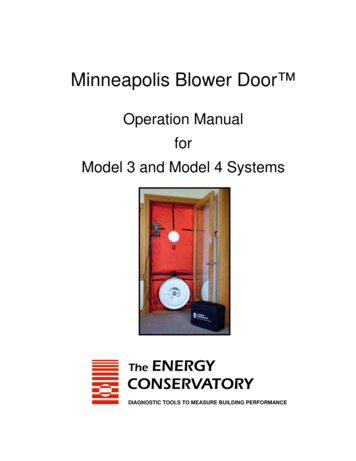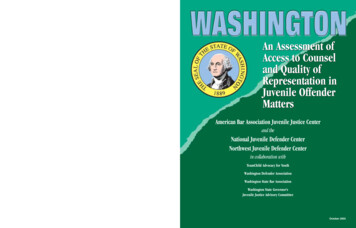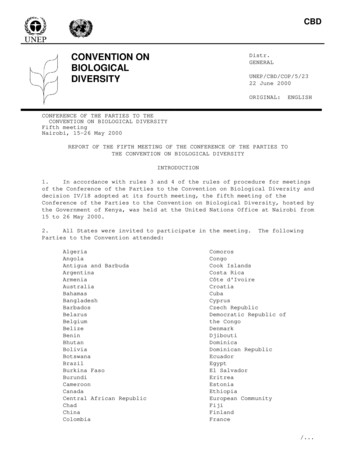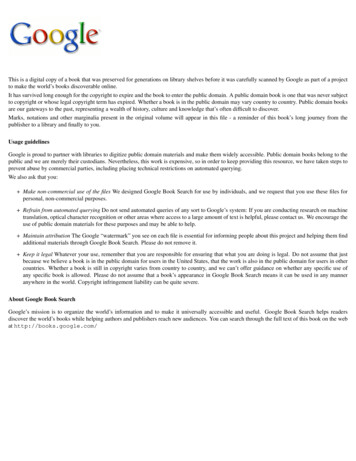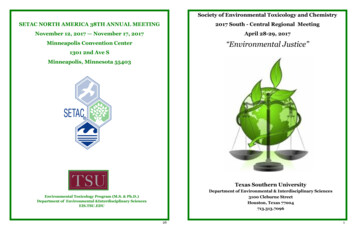
Transcription
Society of Environmental Toxicology and ChemistrySETAC NORTH AMERICA 38TH ANNUAL MEETING2017 South - Central Regional MeetingNovember 12, 2017 — November 17, 2017April 28-29, 2017Minneapolis Convention Center“Environmental Justice”1301 2nd Ave SMinneapolis, Minnesota 55403Texas Southern UniversityDepartment of Environmental & Interdisciplinary Sciences3100 Cleburne StreetHouston, Texas 77004713.313.7096Environmental Toxicology Program (M.S. & Ph.D.)Department of Environmental &Interdisciplinary SciencesEIS.TSU.EDU261
VISITORS PARKING TO SCIENCE CENTER Follow green arrow to come to Science Building from the Parking Garage. Parking fee is 3.00 per day.225
LIST OF AUTHORSPamela Denkins, Texas Southern UniversityPaul L. Klerks, University of Louisiana, LafayettePaul Stonum, Texas Tech UniversityT. Todd Jones, National Oceanic and AtmosphericAdministrationToluwani O. Adebayo, Texas Southern UniversityMeeting AgendaUday Turaga, Texas Tech UniversityPavani Gonnabathula, Texas Southern UniversityVeronica Edirveerasingam, University of California, DavisPaxton Payton, U.S. Department of AgricultureVidyakiran Polaki, Texas Southern UniversityPeter Bruns, Texas Christian UniversityVivek Mann, Texas Southern UniversityPhilip N. Smith, Texas Tech UniversityWarren Berggren, University of North TexasPhillip Gschwend, Massachusetts Institute ofTechnologyWarren Conway, Texas Tech UniversityQing Li, Texas Southern UniversityRaph Townsend, University of California, DavisRay W. Drenner, Texas Christian UniversityRonald J. Kendall, Texas Tech UniversityRussel Wigart, El Dorado County, CASara A. Pappas, Texas Tech UniversityWilliam Thompson, Texas Tech UniversityFriday, April 28, 201712:00 p.m.— 1:00 p.m.Registration1:00 p.m.— 5:00 p.m.Student WorkshopScience Building , 303HRegistrationBreakfastGreetingsScience Building, AtriumScience Building, AtriumScience Building, Room 156Saturday, April 29, 2017Willie Williams, Texas Southern UniversityW. Baylor Steele, Baylor University7:30 a.m.— 10:30 a.m.7:30 a.m.— 8:20 a.m.8:00 a.m.— 8:20 a.m.W. Casan Scott, Baylor UniversityXiaohong Qin, Donghua UniversityDr. John Sapp, Dean, College of Science, Engineering, and TechnologyDr. Shishir Shishodia, Chair,Department of Environmental & Interdisciplinary SciencesZachary Winfield, Baylor UniversityZivar Yousefipour, Texas Southern UniversitySarah Guberman, Baylor UniversitySarah J. Webb, Texas Tech UniversitySascha Usenko, Baylor University8:20 a.m.— 9:40 a.m.9:40 a.m.— 9:55 a.m.9:55 a.m.— 11:30 a.m.Platform Session IBreakPlatform Session IIScience Building, Room 15611:30 a.m.— 12:50 p.m.12:50 a.m.— 2:10 p.m.2:10 p.m. — 2:25 p.m.2:25 p.m. — 3:50 p.m.4:00 p.m.— 4:30 p.m.4:30 p.m.— 5:30 p.m.6:00 p.m.— 7:30 p.m.LunchPlatform Session IIIBreakPlatform Session IVBusiness MeetingPoster SessionAwards DinnerScience Building, AtriumScience Building, Room 156Science Building, Room 156Scott Longing, Texas Tech UniversitySeenivasan Subbiah, Texas Tech UniversitySelina Hernandez, Debakey High SchoolSeshadri Ramkumar, Texas Tech UniversityShaka Jamadar, Texas Southern UniversityShanoy C. Anderson, Texas Tech UniversityScience Building, Room 156Science Building, Room 146Science Building, AtriumScience Building, AtriumShishir Shishodia, Texas Southern UniversitySunday, April 30, 2017Shodimu-Emmanuel Olufemi, Texas SouthernUniversity9:00 a.m.— 11:30 a.m. Toxic Tour ( Cancelled)Steven Lasee, Texas Tech UniversityThao Nguyen, Texas Southern UniversityTheresa Jibunor, Texas Southern UniversityTiffanie A. Brooks, Texas Tech UniversityTodd A. Anderson, Texas Tech University243
LIST OF AUTHORSPLATFORM PRESENTATION SCHEDULEJennifer Apell, Massachusetts Institute of TechnologyLihua Lou, Texas Tech UniversityLissette Aguilar, Baylor UniversityLoretta Olamigoke, Texas Southern UniversityJennifer M. Lynch, National Institute of Standards MacGregor Hall, Texas Christian Universityand TechnologyMadeline Hannappel, Texas Christian UniversityJeremy E. Wilkinson, Texas Tech University/2RTLMahmoud A. Saleh, Texas Southern UniversityGenomicsMorning Platform Session I1. Shanoy C. Anderson2. Peter C. Bruns3. Caleshia S. Calvin4. Matthew J. Fiala5. Marco E. FrancoJeremy L. Conkle, Texas A&M University- CorpusChristiJianbang Du, Texas Southern UniversityMorning Platform Session II1. Amanda French2. Pavani Gonnabathula3. Alex Kascak4. Julie C. Kryzkwa5. Steven Lasee6. Lihua LouJocylin Pierro, Texas Tech UniversityJohn Kasumba, Texas Tech UniversityMariam Bado, Texas Southern UniversityJone Corrales, Baylor UniversityMarlo K. Jeffries, Texas Christian UniversityJoseph Shaw, Indiana UniversityMarc Rice, Hawaii Preparatory AcademyJulie Krzykwa, Texas Christian UniversityMaruthi Sridhar Bhaskar, Texas Southern UniversityKasturi Ranganna, Texas Southern UniversityKatherine Shaw, Texas Tech UniversityKelli Holt, Texas A&M University- Corpus ChristiKelsey N. Thompson, Texas Tech University/2RTLGenomicsAfternoon Platform Session II1. Eric M. Peterson2. Mitchell Schynder3. Kelsey N. Thompson4. Onyanobi Abel-AnyebeMallory M. Seemann, Texas Southern UniversityMarco E. Franco, University of Louisiana, LafayetteKarla S. Marriott, Texas Southern UniversityAfternoon Platform Session I1. Jason Magnuson2. Michelle M. Memanus3. Mourina O. Mogem4. Celeste Ortega-Rodriguez5. Elias OziolorMahsa Esmaeili, Texas Southern UniversityMatthew J. Fiala, Texas Southern UniversityMatthew M. Chumchal, Texas Christian UniversityMatthew Joseph, Texas Southern UniversityMeriel C. LeSueur, Texas Christian UniversityMichelle McManus, Texas Tech UniversityKevin Anthony, Texas Southern UniversityMike Wages, Texas Tech UniversityKimberly D. Hickok, Texas Tech UniversityMitchell Schnyder, Texas Southern UniversityKimberly J. Wooten, Texas Tech UniversityMomho A. Yakubu, Texas Southern UniversityKimberly Young, Indiana UniversityMounira O. Morgem, Texas Southern UniversityKirkland Polk, Texas Christian UniversityNaveen Kumar, Texas Tech UniversityKorry Huddleston, Uuiversity of Houston, ClearLakeNicholas R. Dunham, Texas Tech UniversityKyle Lauck, Texas Christian UniversityKyle Roush, Texas Christian UniversityLauren A. Kristofco, Baylor UniversityLeah M. Thornton, University of North Texas/TCUNissi Abraham, Texas Southern UniversityNkem Azu, Texas Southern UniversityNoah Reid, University of California, DavisOmana Philips, Texas Southern UniversityOnyanobi Abel-Anyebe, Benue State PolytechnicLeandra Stewart, Texas Southern UniversityLei Yu, Texas Southern University423
LIST OF AUTHORSAaron Roberts, University of North TexasAdemola D. Adejayan, Texas Southern UniversityAfolabi Adisa, Texas Southern UniversityAlamelu Sundaresan, Texas Southern UniversityAldana S. Aldawsari, Texas Southern UniversityAlex Kascak, University of Louisiana, LafayetteAlexis Olivias, Texas Christian UniversityAmanda French, Texas Tech UniversityAmmrutha Immadi, Debakey High SchoolAndrew Whitehead, University of California, DavisAngela L. Peace, Texas Tech UniversityAngelica D. Jimenez, Texas Southern UniversityAngella A. Gentles, Texas Tech UniversityAaron Roberts, University of North TexasDesirée A. Jackson, Texas Southern UniversityDonna J. Shaver, National Park ServicesEdward Williams, Texas Christian UniversityElvis Okoro, Texas Southern UniversityEric M. Peterson, Texas Tech UniversityErnest E. Smith, Texas Tech UniversityFatimah Alhamadah, Texas Southern UniversityFawzia Abdel-Rahman, Texas Southern UniversityReproductive Effects of Early Life Stage Thyroid Disruption in the Fathead MinnowGalvin N. Saari, Baylor UniversityGeorge Balazs, National Oceanic and AtmosphericAdministrationG.A. Ocheche, Benue State PolytechnicBethany L. Pierce, Texas Christian UniversityHabibur Howlider, Texas Southern UniversityBridgett N. Hill, Baylor UniversityHaley Egan, Texas Christian UniversityBruce E. Felgenhauer, University of Louisiana,LafayetteHoda Eltayeb, Texas Southern UniversityChukwunonso A. Anakwue, Texas Southern UniversityCindy Howard, Uuiversity of Houston, Clear LakeCole Matson, Baylor UniversityPeter C. Bruns, B eth an y L. Pierce, M allo ry M . Seem an n, a nd M a rlo K . JeffriesExposure to contaminants during development have the potential to cause adverse biological alterations that can persist through depuration periods and into adulthood. This study examined the effects of chemically induced, early-lifestage thyroid disruption on endpoints associated with thyroidal and reproductive function in the fathead minnow(Pimephales promelas). Fish were exposed to propylthiouracil (PTU) from 1 to 43 days post hatch (dph) to induce hypothyroidism. At the end of exposure, length and weight were measured and samples were taken for gene expressionanalysis. The remaining fish were transferred to un-dosed water and raised to maturity and, at 164 dph, a 21-day breeding assay was performed. At the end of exposure, fish exposed to PTU had significantly reduced length, weight, and condition factor. There were also significant differences in expression of several genes involved in the thyroid and reproductive signaling systems. After maturation, there were no significant differences in any morphological variables. During the 21-day breeding assay, fish exposed to PTU during development had significantly reduced number of clutchesand eggs per clutch, and significantly reduced overall fecundity. The results show that early-life-stage hypothyroidismcan affect reproductive function later in life even after thyroid related endpoints have returned to control levels.Cytochrome P4501A Expression in Chorioallantoic Membrane, Liver, and Skin of Kemp’s Ridley SeaTurtles (Lipidochelys Kempii)Hongnan Zhang, Donghua UniversityHyun-Min Hwang, Texas Southern UniversityCaleshia S. Calvin, K im berly D. Hick o k , Jan et E. Y acabu cci, Do nna J. Sh aver, Céline A.J. Go dard CoddingIvory Ellis, Texas Southern UniversityJaclyn E. Cañas-Carrell, Texas Tech UniversityCeleste Ortega-Rodriguez, Texas Christian UniverJames Kennedy, University of North TexassityCéline A.J. Godard-Codding, Texas Tech UniversityA method for determining chlortetracycline residues in edible white-tailed deer tissues, using liquid chromatographwith heated electrospray ionization and mass spectrometer detection. The procedure involved an extraction with EDTAMcIlvaine buffer at pH 4.0, followed by solid-phase extraction cleanup using a Hydrophilic-Lipophilic Balance (HLB)cartridge. The liquid chromatography analysis was performed with heated electrospray ionization and mass spectrometry detection. The limit of quantification for the method was 2.7µg/kg and limit of detection was 0.8 µg/kg. The recovery values were greater than 78.5% for muscle, 65.1% for kidney, 63.1% for liver. Mean tissue residue concentration ofchlortetracycline (CTC) and it’s epimer 4-epi chlortetracycline (4-epi-CTC) at 10-day withdrawal period for kidney, liver, muscle 122.8, 44.7 and 26.7 µg/kg respectively. Chlortetracycline tissue residue concentration at 45-day withdrawalperiod for kidney, liver, muscle 19.2, 28.9 and 10.7 µg/kg respectively. Mean tissue concentration of CTC 4-epi-CTCwere less than the established maximum residual limit (MRL) values for bovine tissues. The method has been successfully used for the quantification of chlortetracycline in white-tailed deer tissue samples.Fengxiang Qiao, Texas Southern UniversityBenjamin Dubansky, University of North TexasCara Woodham, Texas Southern UniversityShanoy C. Anderson, S een ivasan Su bb iah , An gella A. Gentles, Pau l S to nu m , Tiffanie A. B ro o k s, Ernest E. SmithElvedina Mansoor, Texas Southern UniversityGregory D. Mayer, Texas Tech University/2RTLGenomicsCaleshia S. Calvin, Texas Tech UniversityChlortetracycline in White-tailed Deer (Odocoileus virginianus) and Supermarket Meat by LiquidChromatograph-tandem Mass SpectrometerElias Oziolor, Baylor UniversityAudrey Player, Texas Southern UniversityBryan W. Brooks, Baylor UniversityABSTRACTS FOR PLATFORM SESSIONDuma Hlangothi, Texas Southern UniversityJanet E. Yacabucci, U.S. Geological SurveyJason A. Rosenzweig, Texas Southern UniversityJason Magnuson, University of North TexasJeff Pawloski, Sea Life ParkJeffrey Back, Baylor UniversityThe 2010 Deepwater Horizon incident is the largest oil spill in the history of the United States. This anthropogenic disaster impacted the Gulf of Mexico’s coastal ecology and exposed countless marine organisms, such as sea turtles, to oil.The primary habitat of the critically endangered Kemp’s ridley sea turtle (Lipidochelys kempii) is the Gulf of Mexico,leading to concern for their welfare and conservation. Under the direction of the U.S. Department of the Interior, a Natural Resource Damage Assessment was put in place to evaluate the effects of this spill and appraise future restorationefforts. The project presented here is part of this assessment. Cytochrome P4501A (CYP1A) expression is a known biomarker of exposure to chemicals, including polycyclic aromatic hydrocarbons present in crude oil. CYP1A protein expression in Kemp’s ridley was evaluated via immunohistochemistry in both skin biopsies of nesting mothers collected in2011 and paired liver and chorioallantoic membrane (CAM) tissues of late stage hatchings collected in 2010 and 2011from Padre Island, TX, USA. CYP1A expression was measured following the methods of Godard et al. (2004). Tissueswere formalin-fixed, embedded in paraffin, sliced by microtome and mounted on microscope slides, prior to stainingwith monoclonal mouse antibody. CYP1A expression was low in all samples analyzed. A moderate positive correlationin CYP1A expression was observed between liver and CAM tissues, supporting the relevance of CAM samples in endangered species studies where non-invasive samples are required. Future analyses comparing CYP1A expression amongstsampling years and various organs is underway.David Klein, Texas Tech University225
ABSTRACTS FOR PLATFORM SESSIONABSTRACTS FOR POSTER PRESENTIONSources of Fine Sediment Particles in Roadway Stormwater Runoff in the Lake Tahoe BasinMatthew Fiala, Hy u n -Min Hwang, Russel Wigart, Raph Townsend, Veronica EdirveerasingamThe clarity of Lake Tahoe water column has declined since the late 1950s. More than 50% of Lake Tahoe’s clarity loss can be attributed to fine sediment particles ( 16 mm) from various sources. This study was to identify major sources of fine sediment particles andassociated phosphorus in winter roadway runoff, quantify the contribution of each major source, and investigate time-series changeof runoff turbidity and elemental composition of fine sediment particles. Roadway runoff samples were collected using ISCO automatic water sampler from two sites (Cattlemans and Pioneer) located on Pioneer-Trail in the Lake Tahoe Basin. Runoff samples weremeasured for turbidity and sieved (20 μm) to collect fine sediment particles. Organic matter content, oil and grease, elements (Co,Cr, Cs, Cu, Fe, Li, Mn, Ni, Pb, V, Zn), and organic markers were quantified to calculate the contribution of fine sediment particlesfrom various sources using chemical mass balance model. Approximately 50% of fine sediment particles in roadway runoff originated from non-traffic related sources such as eroded soil and vegetation debris from road side hills. It is interesting to note that asphaltpavement wear particles accounted for 30.6 7.6%, which is the second most abundant source of fine sediment particles in collectedroadway runoff. These particles were produced when snow plow steel blades and tire chains grind asphalt pavement. The contribution of abrasive sand 16.2 4.3%. To reduce the loading of fine sediment particles and avoid installation of new treatment BMPs,side hill soil erosion control and new roadway management practices (e.g., plastic blade rather than steel blade for snow plow) mustbe adopted.Crude Oil Disrupts Bioturbation Activity, Increases Oxidative Stress and Results in Histopathological Changes inthe Hepatopancreas of the Fiddler Crabs Uca Longisignalis and Uca Panacea from the Northern Gulf of MexicoIn-Vehicle Noise Pollution Exposure on HighwaysQing Li, Fengxiang Qiao, Lei YuNoise is one of the typical hazardous emissions. Regular and long-term exposure to elevated noise can bring about various adversehealth effects, such as hearing impairment, hypertension, ischemic heart disease, annoyance, and sleep disturbance. Various noisepollution controls have been implemented in households, industries, traffic and other noise sources; whereas an automobile cab hasbeen never regarded as a place that needs to protect passengers and drivers from the noise. In practice, most of the people in the U.S.still rely on their personal vehicles for mobility and each of them spends plenty of time on daily commuting and being stuck in traffic.There is a lack of studies in the in-vehicle noise exposure levels during commuting time and the risk of adverse health consequencesto the public. This research intends to investigate the distribution of the in-vehicle noise exposure, assess the risk of the in-vehiclenoise exposure for commuters. An on-road driving test was conducted on the State Highway 288 in Houston Texas in May 2016.Twelve subjects were recruited to drive a dedicated vehicle through a designed 35-km-long test route. The test vehicle’s real-timeactivity information and in-vehicle sound levels were collected by an On-board Diagnosis II and a digital sound meter, respectively.Results show that commuters are chronically exposed to the in-vehicle noise at the level between 75 dB(A) and 85 dB(A) on highways, which can cause negligible risk of hearing impairment.Marco E. Franco, Pau l L. K lerk s, B ru ce E. Felgen h au erDetermining Phytotoxicity of Carbon Nanotubes in Heat and Drought Stressed CropsTwo of the most common macroinvertebrate species in coastal ecosystems from the northern Gulf of Mexico are the gulf marsh fiddler crab (Uca longisignalis) and the gulf sand fiddler crab (Uca panacea). Their burrowing and feeding activities are fundamental forsediment oxygenation and nutrient availability in coastal sediments. Due to high activity of the oil and gas industry in the gulf andthe prominent danger for oil spills, fiddler crabs are at a constant risk of being exposed to crude oil. To obtain insight into the toxicityof crude oil to fiddler crabs, mesocosms were established in a greenhouse, and filled with sediment and water from fiddler crab collection sites in Grand Isle, LA. Experiments were conducted for 10 days, for each species separately and for both species combined.Fiddler crabs were exposed to crude oil concentrations of 5 to 55 mg/cm2, by spreading an oil-sediment mixture over the sedimentsurface in each mesocosm. Oil exposure led to significant reductions in burrow size (diameter, depth and volume) and in their bioturbation (mixing of surface sediment to different depths). Additionally, both species showed increased oxidative stress, quantifiedby the TBARS assay, after exposure to high concentrations of crude oil. Because oxidative stress usually induces membrane damage,light microscopy is currently being used to assess the occurrence of morphological changes and histological damage in hepatopancreas cells. The results from this study provide further insight into the potential for oil spills to disrupt the important ecological processes mediated by fiddler crabs.Juliette Jordan, Jaclyn E. Canas-Carrell, Paxton Payton, David TissueCarbon nanotubes (CNT) are manufactured nanomaterials currently being used in medical and pharmaceutical devices, waste watertreatment, and electronics. Because of their wide range of uses and small size, CNTs are an emerging and growing contaminant ofconcern. This study evaluated the effects of multi-walled carbon nanotubes (MWCNTs) in soil on heat, drought stressed tomato anddrought stressed cotton. Tomato plants were grown in a greenhouse under regular growing conditions during which time the greenhouse was held at an average temperature of 28ºC (day and night). Cotton plants were not grown under heat stress. A subset of bothtomato and cotton plants was also subjected to water deficit conditions. Photosynthetic response was measured before, during, andafter the water deficit. Plants grown in soil mixed with CNTs showed delayed early growth. CNT exposure influenced tomato andcotton plant photosynthetic response to water deficit stress. Results of past studies have varied depending on plant species and typeof CNT. However, whether there is variability in stress response or an impact of climate for different species has yet to be determined. More research is needed on the effects CNTs have on different crop species and different genotypes under varying environmental conditions.Presence of Antimony as Evidence of Lead Shot Ingestion by American WoodcockAmanda French, W arren Co n w ay, David K leinLead (Pb) ammunition left in the environment can be consumed by birds and cause health problems including lethargy, anorexia,and death. The danger of Pb ammunition has been well documented in waterfowl, but remains a concern for webless migratory gamebirds, upland gamebirds, and scavenger species. The American woodcock (Scolopax minor) is a small, webless migratory gamebirdknown to have elevated tissue Pb concentrations. The primary source of Pb in woodcock is postulated to be Pb shot, however, currentsource determination methods have not substantiated this claim. To identify a reliable and consistent signature of Pb shot presencein birds, we hypothesized that the trace metal antimony (Sb) would be a suitable indicator of Pb shot exposure. Antimony is added toPb shot pellets to increase pellet hardness and is not found in high concentrations (typically 0.5 ppm) within the environment.Therefore, Sb would be a reliable indicator of Pb shot exposure in woodcock if Sb is 0.5 ppm in woodcock tissue, as Pb shot is themost likely source of elevated Sb. Lead and Sb concentrations were determined in 196 hatch year ( 10 month old) woodcock feathers and wing bones. A positive correlation between Pb and Sb (feather r 2 0.51; bone r2 0.80) was found in both tissues, indicatingthat Pb shot is a source of elevated Pb in woodcock. This experiment has provided proof of concept to show the potential reliability ofusing antimony as an indicator of Pb shot exposure in birds621
ABSTRACTS FOR POSTER PRESENTIONABSTRACTS FOR PLATFORM SESSIONEffects of Emerging Contaminants at Trace Level on Nitric Oxide (NO) Levels and Superoxidedismutase (SOD)Activity in Mice: Role of Sex and PPARα26. Impact of Ramp Metering Strategy on Vehicle Exhaust EmissionsPavani Gonnabathula, Mo m o h A Y ak u bu ,Jianbang Du, Qin g Li, Fengxian g Qiao , Lei Y uRamp meters are signal devices installed on highway ramps to regulate the traffic flow according to current traffic conditions onhighway. Texas Department of Transportation has operated 60 ramp meters in Houston district since 1990s. The ramp meteringstrategy increases the average vehicle speed and decreases the accident rate and driving time significantly. However, there is no sufficient study focusing on vehicle exhaust emissions at ramp metering. This research attempts to obtain an insight into vehicle emissionlevels when the ramp metering strategy is implemented. On-road driving tests were conducted during peak and non-peak hoursalong the South Bound of Houston highway I-45 N, which includes 6 on-ramps. The ramp meters were activated mainly during peakdepending on traffic demands. The exhaust emission data was collected on a dedicated light-duty vehicle by using a portable emissions measurement system (PEMS), an On-Board Diagnosis (OBD) II recording system, and a GPS device. Statistical result showedthat the on-ramp exhaust emissions were increased while the mainline exhaust emissions decreased if the ramp metering strategiesare activated. Since the ramp flow is far less than the mainline flow, the entire exhaust emissions for the whole highway system weredecreased. This means that a ramp metering strategy could induce the air quality benefit of the highway system. It is suggested further improving ramp metering strategies towards an integrated control in Houston highway system for better beneficial effects.27. Subleathal Toxicity of the Harmful Haptophyte Pryminesium Parvum to Two Common Fish SpeciesBridgett N. Hill, Jo n e Corrales, Lau ren A. K risto fco , W . B ay lo r Steele, Gavin N. Saari, W . Casan Sco tt, B ry an W .BrooksAnthropogenic activities and climate change have resulted in a global increase in the occurrence of harmful algae blooms (HABs).Prymnesium parvum is an invasive toxin producing haptophyte commonly referred to as “golden algae” or the “Texas Tide” thatforms HABs leading to massive fish kills. Though we have made progress understanding factors leading to ambient toxicity associated with bloom development and termination, an understanding of how P. parvum may affect fish sublethally (e.g., compromises tosurviving fish) is not available. In the present study we aimed: (1) to determine if sublethal biochemical and molecular oxidativestress (OS) responses occur after exposure to P. parvum cultures; (2) to determine if sublethal OS responses are altered by nutrientlimitation; and (3) to compare whether OS responses varied between two common fish species, the fathead minnow (Pimephalespromelas) and zebrafish (Danio rerio), following standard aquatic toxicology approaches. P. parvum cultures were grown untilstationary phase was reached under nutrient sufficient (f/2) and deficient (f/8) conditions following methods previously reported byour group. Initial studies were conducted to identify acute LC50 values for fathead minnow and zebrafish prior to and following exponential growth. Sublethal concentrations of both P. parvum cultures were used to examine traditional biomarkers of OS (lipid peroxidation, DNA damage, total glutathione), and antioxidant gene activation (changes in nrf2, gclc, gst, sod) in fish larvae. To ourknowledge, this study represents the first attempt to understand mechanistic toxicity responses in general and oxidative stress inparticular of fish to P. parvum.Toxicological effects of traditional water contaminants such as lead and arsenic are well known. Recently, trace amounts of chemicalpollutants such as pharmaceuticals, personal care products, pesticides, herbicides and endocrine disrupting compounds are detectedin our drinking water. These trace chemical pollutants pose environmental and human health concerns. So, we have investigated theeffects of trace concentrations of multiple pesticides (MP) on the regulation of NO signaling molecule levels and SOD activity in thetissues from wild type and PPARα knockout mice. Wild type/ PPARα knockout mice (male and female) were exposed to trace concentrations of multiple pesticides comprising atrazine, dieldrin, endrin, endosulfan and anthracene (1- 100ng/L) in drinking waterfor six weeks. Blood and organs were collected, homogenized and NO levels and SOD activity were determined by Griess/SOD assays. In the blood samples, treatment with low MP reduced NO (20%) in the female with no change in the male. NO level was 90%higher in wild type compared to PPARα knockout female. NO levels increased in tissues from wild type: spleen (80%), heart (75%),liver (80%), kidney (85%) and brain (85%), while in PPARα knockout NO levels was reduced in spleen (45%) but increased in thekidney (55%) with no change in the brain, liver, and heart. In the male, NO levels were reduced in the heart (66%) and liver (40%)with no change in the kidney, spleen, brain, and testicles. Blood SOD activity is 90% greater in male than female; MP attenuatedSOD activity by 20% with no change in the female. Female tissue SOD activity was significantly reduced in the heart (30%), liver(25%) and spleen (25%) of treated mice with no effect in the brain and the kidney. In the PPARα knockout mice, SOD activity wassignificantly increased in the heart (50%) and liver (25%) but not in the kidney, spleen, and brain. Thus, low concentrations of multiple pesticides caused selective dysregulation of NO/SOD systems in different organs of the body. The effects observed was sex dependent and may be influenced by genetic status as in PPARα knockout. These results present a scenario that implicates nano levelsof series of organic contaminants that can cause cellular and molecular dysregulations of biomolecules precipitating toxicity and pathology that can be a threat to human health. Further investigation into the molecular mechanism(s) and signaling pathway(s) implicated in these dysregulations is warranted and is of interest.Lethality of Crude Oil on Lepidophthalmus Louisianensis at Various Life StagesAlex Kascak, Paul L. KlerksLepidophthalmus louisianensis, commonly known as the ghost shrimp, lives along the northern coast of the Gulf of Mexico (GoM)in subtidal and intertidal areas. This species creates burrows that can reach depths greater than two meters. These burrows will connect below the sediment surface and create a large network. The presence of the shrimp and their burrow structures alters abioticand biotic factors, allowing the shrimp to have a large impact on the area. Living on the coast in the GoM means that this species is atrisk for crude oil exposure due to an oil spill as happened in 2010 due to the Mancondo well blowout. Experiments are being conducted on adult and larval individuals to assess the lethality of the crude oil. Experiments are conducted within environmental chambers to control light and temperature. Adult shrimp are exposed individually within microcosms to crude oil applied at the surface;larval shrimp are exposed in groups within glass beakers to the water-accomodated fraction (WAF). Toxicity tests are short as theyare intended to determine acute toxicity. Preliminary results for larval survival of the zoea and decapodid life stages show a muchgreater resistance to WAF
Peter C. Bruns, Bethany L. Pierce, Mallory M. Seemann, and Marlo K. Jeffries sist through depuration periods and into adulthood. This study examined the effects of chemically induced, early-life-(Pimephales promelas). Fish were exposed to propylthiouracil (PTU) from 1 to 43 days post hatch (dph) to induce hy-pothyroidism.

